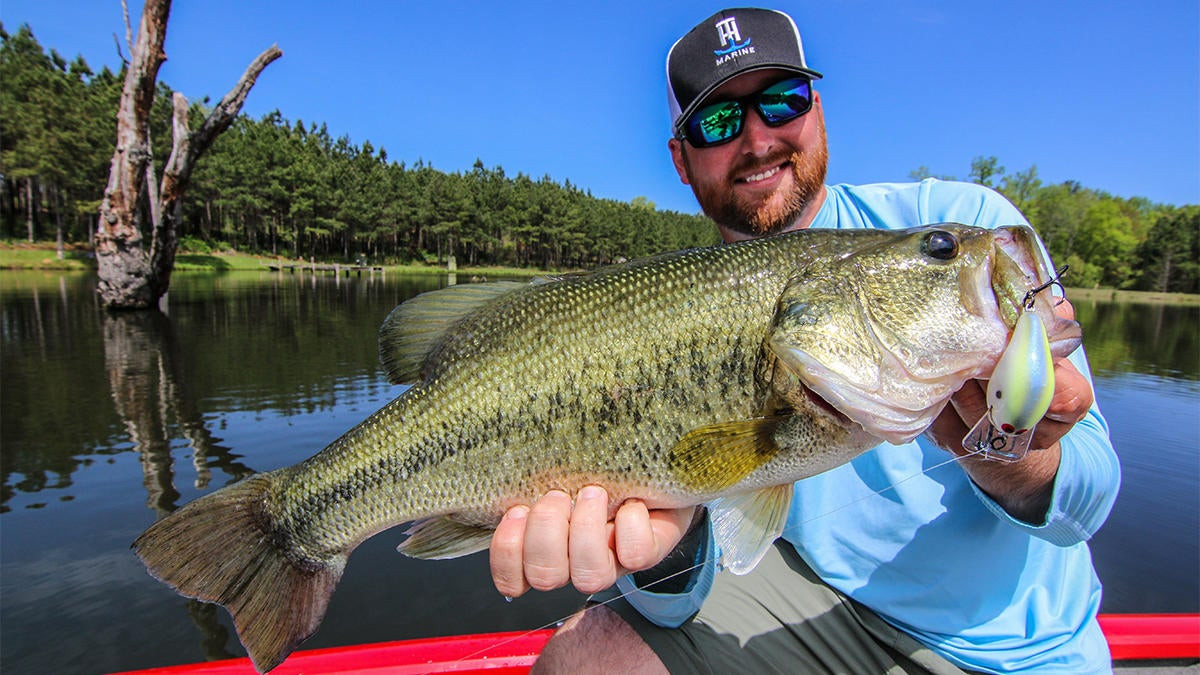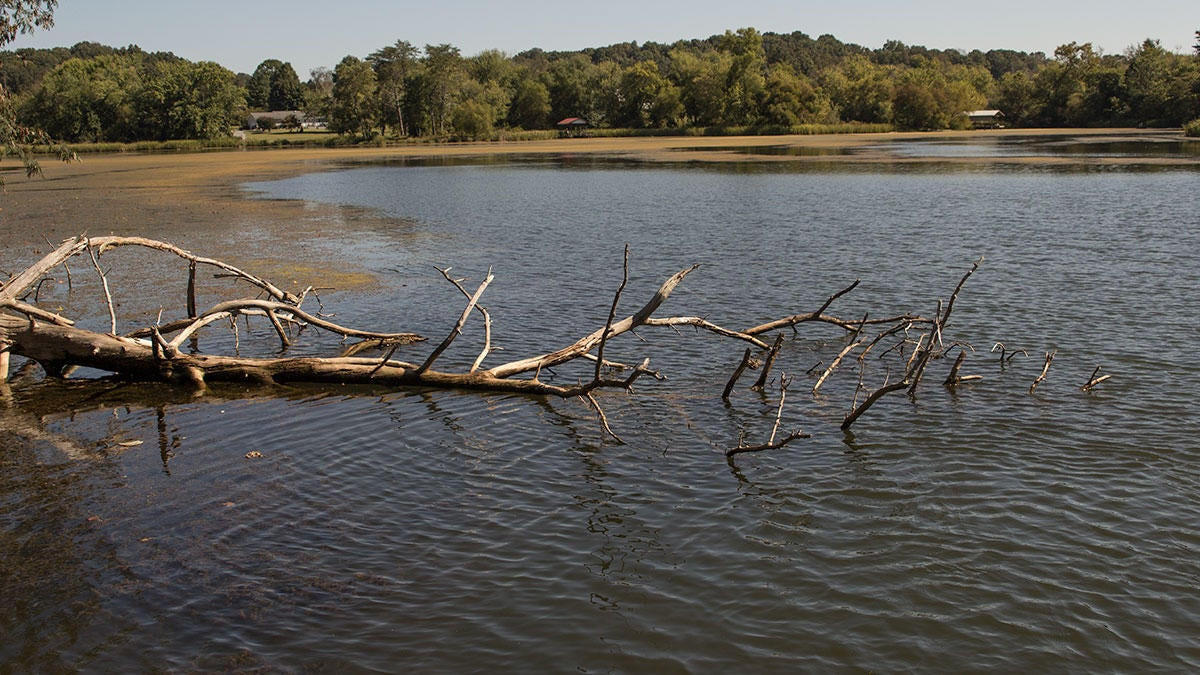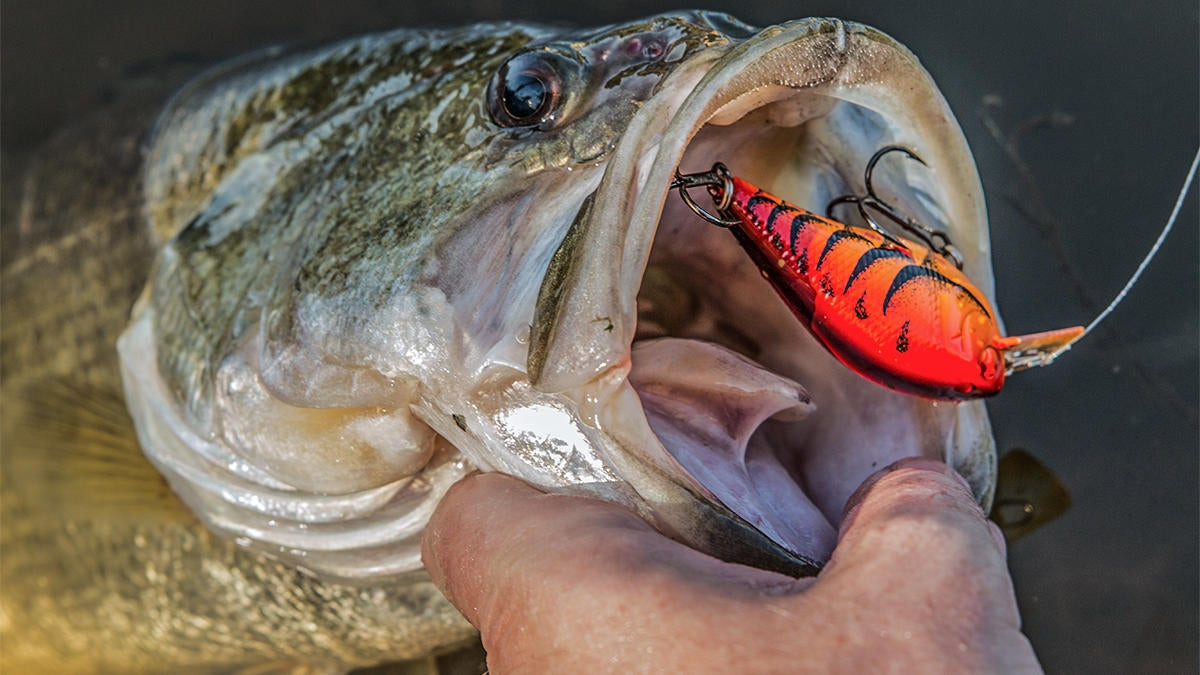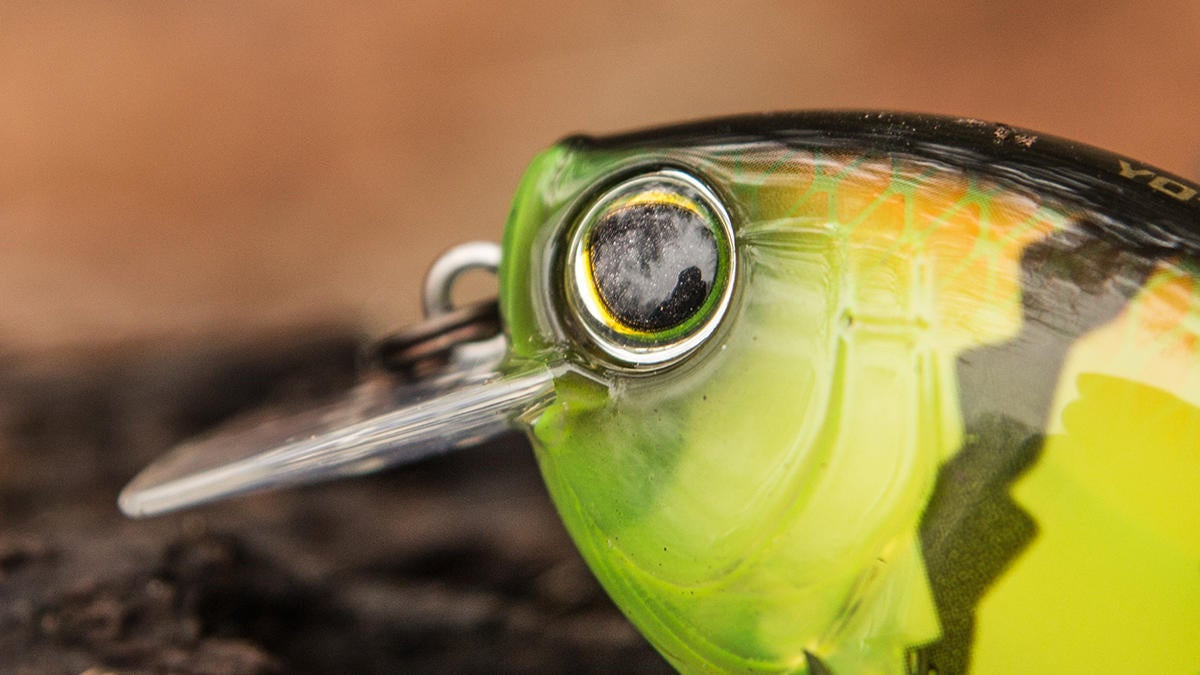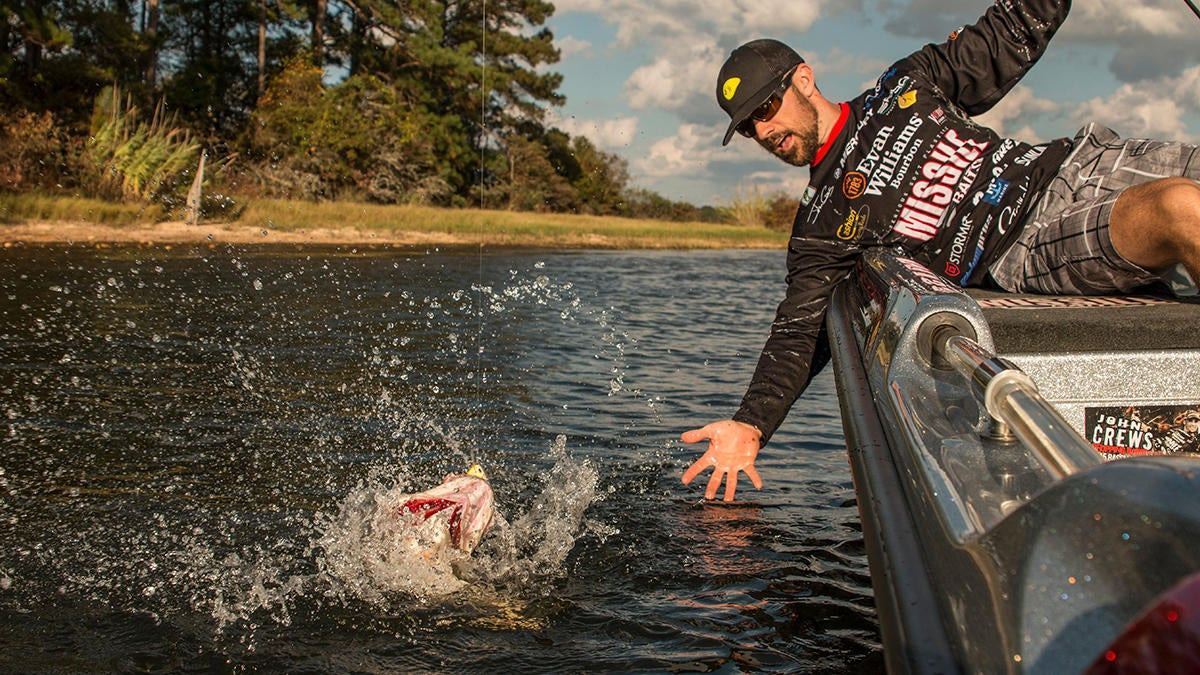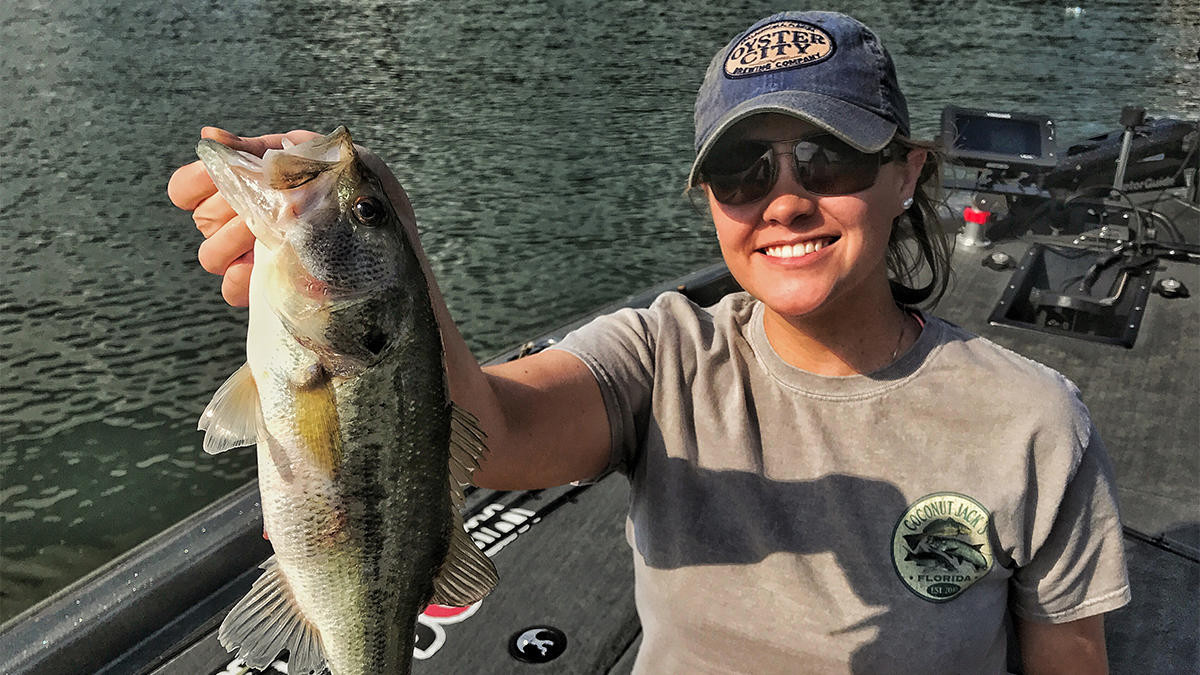Lots of anglers are fishing in deep water right now. It’s hot and the bass fishing is tough for most of us. As I type this, there are thousands of bass boats floating atop offshore ledges hoping to find the motherlode of summertime bass. Many of them will find gold but others will find nothing but a sunburn.
I would put myself in the latter group. I certainly don’t consider myself an offshore fishing expert by any means. I can do it a little bit, but it will never be my strength; not even by a longshot. While some guys go out and beat on ’em in 25 to 30 feet of water, I’m running down the bank as fast as I can chucking a squarebill around. I prefer to stick to my strengths this time of year. If it’s going to be tough, I feel much more comfortable doing something I have confidence in.
While a lot of fish do, in fact, move to deeper water this time of year, there’s still a sizeable number that stay put in the shallows. Heck, some bass—often referred to as resident fish—live their entire lives in just a few feet of water. Let’s not get so caught up in the deep game that we completely overlook the low-hanging fruit in the shallow areas.
Because I fish a squarebill all year long, I’ve been able to pick up on a lot of important subtleties depending upon the season. You can’t fish a squarebill the same way for 12 months and expect it to produce consistently. So I wanted to share a few things I’ve learned that will help you crush ’em this summer on a shallow-running squarebill.
Avoid a constant retrieve around cover
Whether you’re fishing around wood, rock or grass, a methodical retrieve seems to be paramount in the heat of the summer. You may be able to catch a few just mindlessly reeling, but thinking your way through every cast will give you an enormous advantage over the fish.
This time of year, bass have very small feeding windows for the most part. You can catch ’em for the first few hours after sunrise and a few hours before sunset. They’re generally most active in those lowlight conditions. But that leaves a huge dead period during the rest of the day. Between these feeding periods, they like to get snugged up to cover and shade. I’m not talking about being around the cover. They’re literally against the cover and touching it.
They’re also very inactive for much of the day. So a little ol’ minnow nonchalantly swimming past them doesn’t really get ’em going. If they think that minnow is injured or dying, however, their biological instincts kick in and they can’t help but attack it. It’s in their DNA.
In angling terms, we often call that a reaction strike. That fish wasn’t hungry. But that erratic action turned that bass into a killing machine. It’s just like a cat with a laser pointer: If you just slowly move it along the floor, the cat is going to look at you like you’re stupid. But you make that red dot move erratically and that cat will do everything it can to attack it.
So when you come across a good-looking piece of cover, make your crankbait dance a little bit. When it gets next to that dock post, twitch it and then follow it up with a pause. Or crank your reel handle really fast for a few turns. Anything you can do to make your crankbait look injured will elicit those reaction strikes.
Stubborn can be a good thing sometimes
I would say that 90 percent of the biggest bass I’ve ever caught have come after repeated casts to the exact same piece of cover. I caught a 13-pounder casting to the same limb more than 15 times just a few years ago. There’s no telling how many 6- to 8-pounders I’ve caught doing the same thing.
Now, I’ll be the first to admit that my stubbornness can really bite me in the butt; it does quite often, actually. But the prespawn period and the heat of the summer are the two times I can actually convince myself that my bullheadedness is a good thing.
We just talked about how the bass love to get into thick cover and deep shade this time of year. We also discussed how lethargic they can be right now. In my mind, that means it’s up to us to tick them off. The odds are they probably aren’t in a major feeding period, so I want to make them bite my squarebill out of anger. And it’s totally possible to make that happen.
Anytime you come across isolated cover such as a stump by itself or a lone dock in the back of a pocket, cast to it at least 10 times with a squarebill. I know that sounds crazy and it’s going to feel crazy until you catch a giant doing it. That big, ugly bass is just sitting there next to that stump watching your crankbait whiz past her face. She’ll ignore it the first few times. Then she’s going to start getting irritated; big bass like to own particular pieces of cover. That’s her stump and she wants your squarebill out of her space. When you finally kill that squarebill right next to the stump or it deflects just right, the cat comes out to chase the laser pointer and that big, ugly bass destroys your plug. You just ticked her off into eating. That’s exactly why repeated casts are so important right now.
Give ’em a big target
I’m not really talking about crankbait size here. I’ve read lots of articles over the years that swear by big squarebills in the summer and I’ve read articles that said the exact opposite. I think all of that is totally dependent upon the size of your local forage. But I digress.
What I am talking about, however, is a way to help that cat find the laser pointer a little bit easier. Something for it to hone-in on, if you will. If you go through my summer squarebill boxes, you’ll notice one of two things: Each crankbait either has oversized eyes or a giant dot behind the gill plate drawn with a permanent marker.
I’ve experimented a bunch with this over the years and I really believe that big ol’ dot on the side of your plug gives the bass a little more incentive to attack your lure. In my opinion, which very well could be incorrect, I think that big dot or eyeball creates more contrast and flash underwater.
I’ve put it in human terms over the years to my guide clients like this: If somebody put a plain hamburger in front of you and you weren’t hungry, you’d probably pass on taking a bite. But if I put a juicy, fresh-off-the-grill cheeseburger with ketchup, mustard and some homegrown tomatoes in front of you, you’re a lot more likely to take a bite even if you just finished supper. They’re both ground beef on bread, but that delicious cheeseburger was a little more unique and gave you more incentive to try it.
I think it’s kind of the same thing with oversized eyes and hand-drawn dots on squarebills. It’s the contrast and differentiation that piques their instincts and interest.
You’re guaranteed to lose fish when you horse them
When the water temperatures get into that 80-degree range, the mouth of a bass gets super soft and loses a lot of elasticity. This means that when your treble hooks penetrate the mouth of a bass in the summer, they’re much more likely to tear a bigger hole. If this happens, one wrong head turn from the bass and they’re gone forever. It happened to me two weeks ago while fishing a tournament with my buddy. I was trying to get a big bass away from cover, I pulled a little too hard and the trebles plucked out right at the net.
Whether you compensate for this by using a lighter-action rod or simply slow your roll when you get a bite, you need to do whatever you can to avoid rushing these fish to the boat. Even though they’re lazy this time of year, those big ones still pull hard. Loosen that drag a little bit and let the fish wear itself out.
It’s a mindset thing: You have to commit
I have had some really special summer days on a squarebill, but on each of those days, I probably never caught more than 10 fish. This isn’t one of those deals where you should expect to go catch 30 fish per day. I’m primarily targeting big, wandering bluegill-eating female bass when I’m fishing this pattern. I don’t fish much “in between” stuff, so I’m very target oriented right now. If it doesn’t look good and give me a good gut feeling, I don’t even bother with it.
My mindset is simple: I want to put that plug in front of as many fish as possible throughout a day of fishing. That means I have to be selective in regards to the stuff I fish. And I also have to be efficient. But if you decide to try this on your next fishing trip, it’s imperative to understand that you will hit dead periods where you don’t get a bite for two or three hours. But then that giant eats it and it gives you the confidence to hang with it. The process repeats and before you know it, you just might have an impressive sack of fish in your livewells at the end of the day.
So in closing, you can absolutely go fish offshore and catch some huge bass right now. But lots of folks out like, like myself, would just rather stick to the shallow stuff and that’s totally fine. The tips we discussed and a patient mindset will help you pick off a few of those big, shallow bass that other guys might be totally missing.


